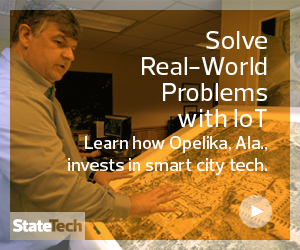Bhide says Tampa Bay “dodged a bullet” with Hurricane Irma in 2017, and while there was no serious flooding following that storm, the city lost power for five days. In a separate project, Bhide says the city will test the ability of solar panels to generate power at traffic intersections.
By using solar power, the city hopes it can generate reserve power so the traffic lights can work following a storm. Bhide says the added power will help the roadways perform more efficiently, improve safety and enhance emergency response. While Bhide cautions that the city still considers the solar project in pilot mode, the city will go out for a full RFP later this year and plans to move forward with the solar project.
MORE-FROM-STATETECH: Find out why connected intersections are the backbones of smart cities.
Boston Adjusts Traffic Signals to Keep Vehicles Moving in Snow
The city of Boston, known as a high-tech hub, has deployed traffic signals timed from a central computer at 593 locations. There are also a series of 550 cameras deployed at intersections that report back to the city’s Traffic Management Center to monitor traffic flow.
Gina Fiandaca, commissioner of the Boston Transportation Department, says during the winter of 2015, when Boston was hit with nine feet of snow inside of three weeks, the TMC would deliver up-to-date information on the status of snow removal and traffic.
“The cameras helped us see what was happening at key intersections, and we followed up by adjusting traffic signal timing remotely from the TMC and deploying law enforcement personnel in the field,” Fiandaca says. “Together, these efforts helped to reduce congestion and keep traffic moving on our streets.”
Boston's signal system lets the transportation department remotely adjust signal timing to help clear vehicles through intersections. It’s also set up to utilize data provided by the Massachusetts Bay Transportation Authority to activate transit priority for buses and light rail vehicles at certain locations.
“We've had many areas in the city that have never flooded until recently, and these systems help us to set up appropriate detours,” Fiandaca says.
Boston’s Public Works Department has also deployed GPS/automatic vehicle location modems on both city and contractor snow plows that make it possible for the city to efficiently track snow removal during Boston’s many snowstorms.
Matthew Bradley, a logistics specialist in the public works department, says the GPS/AVL modems get installed right into the dashboards of city vehicles, and contractors can attach them to accessory power outlets in their vehicles. The system generates reports such as how many times a street was plowed, the fuel efficiency of the vehicle and how much time a plow spent at a location.
“It can even tell us if an engine light has gone off on a vehicle,” Bradley says. “Some drivers also use the modems as Wi-Fi hotspots for vehicle-mounted tablets that are used to access the GPS/AVL system in their vehicles and view reports.”
Meanwhile, WBZ4 in Boston reports that Boston is hard at work testing the next generation of traffic lights. Chris Osgood, Boston's "chief of streets," tells the station that these traffic lights will essentially talk to one another, and will be “traffic signals that don’t just function independently but actually can work as an entire network.”
MORE-FROM-STATETECH: Find out how cities can overcome challenges to smart city deployments.
Madison Manages Traffic Flow During Floods
Yang Tao, city traffic engineer in Madison, Wis., says the city’s intelligent transportation system runs over the city’s fiber backbone, and combined with a modern traffic signal management system, the city can change signal timing during significant weather events such as floods and snowstorms. For example, Madison experienced frequent flooding in 2018 when the many lakes that surround the city overflowed.
“In the past, we used to have to send out field people to the physical traffic lights to make a timing change, but now we can do it efficiently right from our offices,” Tao says.
Madison has also been preparing for the era of autonomous driving and enhanced technology in cars. For example, it’s working on a pilot project that’s testing sending out alerts to motorists in the event of a flood or icy conditions on the roads. Tao says the system can send the messages out either via dedicated short-range communications or over mobile networks such as 5G, as the technology becomes more available.
“We can also just send out the alerts to a user’s phone app when the phone gets mounted on the dashboard,” Tao says. “Over time, more and more cars will have these high-tech capabilities.”
Mark Zannoni, research director for smart cities and transportation for IDC Government Insights, says while cities use ITS to improve road safety and mitigate congestion during major weather events, ITS deployments for weather emergencies are often tough for cities to justify.
“However, global warming is expected to increase the frequency and intensity of storms, as well as changes in weather patterns, so in the future, weather could drive some ITS investments — such as if a southern city suddenly faces numerous issues with ice on streets and a corresponding spike in accidents,” Zannoni explains. “But I see ITS investments by cities continuing to address broader issues like safety, congestion, air quality, transit performance and system reliability. These could certainly improve matters during weather emergencies, but for most ITS investments by cities, weather would not be the primary driver.”











